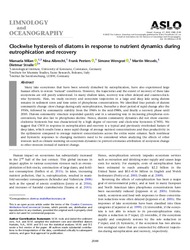Clockwise hysteresis of diatoms in response to nutrient dynamics during eutrophication and recovery
DOI: https://doi.org/10.1002/lno.12190
Persistent URL: http://resolver.sub.uni-goettingen.de/purl?gldocs-11858/10262
Persistent URL: http://resolver.sub.uni-goettingen.de/purl?gldocs-11858/10262
Milan, Manuela; Albrecht, Nina; Peeters, Frank; Wengrat, Simone; Wessels, Martin; Straile, Dietmar, 2022: Clockwise hysteresis of diatoms in response to nutrient dynamics during eutrophication and recovery. In: Limnology and Oceanography, Band 67, 9: 2088 - 2100, DOI: 10.1002/lno.12190.
 |
Dokument öffnen: |
Many lake ecosystems that have been severely disturbed by eutrophication, have also experienced large human efforts to restore “natural” conditions. However, the trajectories and the extent of recovery of these lake ecosystems are still poorly understood. In many shallow lakes, recovery was often delayed and counter‐clockwise hysteretic. Here, we study recovery and ecosystem trajectories in a large and deep lake using diatom remains in sediment cores and time series of phosphorus concentrations. We identified four periods of diatom community change: slow change during early eutrophication, thereafter a short period of rapid change after the 1950s, followed by community stability from the 1960s to the mid‐1980s, and finally a recovery phase until 2010. Diatom community structure responded quickly and in a saturating way to increasing phosphorus concentrations, but also fast to phosphorus decline. Hence, diatom community dynamics did not show counter‐clockwise hysteresis but was characterized by a high degree of recovery and clock‐wise hysteresis (CWH). We suggest that CWH in response to eutrophication and recovery is a typical and previously overlooked feature of deep lakes, which results from a more rapid change of average nutrient concentrations and thus productivity in the epilimnion compared to average nutrient concentrations across the entire water column. Such nonlinear and hysteretic responses to changing nutrients need to be considered when analyzing the effects of other stressors such as climate warming on ecosystem dynamics to prevent erroneous attribution of ecosystem change to other stressors instead of nutrient change.
Statistik:
ZugriffsstatistikSammlung:
Schlagworte:
lake ecosystemsLake Constance
changing phosphorus concentrations
Diatom community change
This is an open access article under the terms of the Creative Commons Attribution‐NonCommercial License, which permits use, distribution and reproduction in any medium, provided the original work is properly cited and is not used for commercial purposes.

